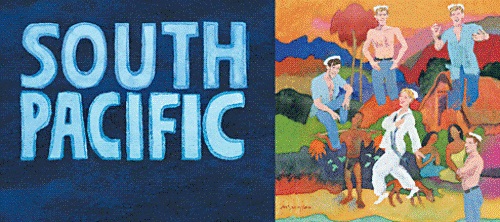
Soon after their purchase of the rights, Rodgers and Hammerstein decided not to include a ballet, as in their earlier works, feeling that the realism of the setting would not support one. Concerned that an adaptation too focused on "Fo' Dolla' ", the story of the encounter between Cable and Liat, would be too similar to Madama Butterfly, Hammerstein spent months studying the other stories and focused his attention on "Our Heroine", the tale of the romance between Nellie and Emile. The team decided to include both romances in the musical play. It was conventional at the time that if one love story in a musical was serious, the other would be more lighthearted, but in this case both were serious and focused on racial prejudice. They decided to increase the role played by Luther Billis in the stories, merging experiences and elements of several other characters into him. Billis's wheeling and dealing would provide comic relief. They also shortened the title to South Pacific – Rodgers related that the producers tired of people making risqué puns on the word "tales".
In early drafts of the musical, Hammerstein gave significant parts to two characters who eventually came to have only minor roles, Bill Harbison and Dinah Culbert. Harbison is one of the major characters in Tales of the South Pacific; a model officer at the start, he gradually degenerates to the point where, with battle imminent, he requests his influential father-in-law to procure for him a transfer to a post in the United States. Hammerstein conceived of him as a rival to Emile for Nellie's affections, and gave him a song, "The Bright Young Executive of Today". As redrafts focused the play on the two couples, Harbison became less essential, and he was relegated to a small role as the executive officer to the commander of the island, Captain Brackett. Dinah, a nurse and friend of Nellie, is also a major character in Michener's work, and was seen as a possible love interest for Billis, though any actual romance was limited by Navy regulations forbidding fraternization between officers (all American nurses in World War II were commissioned officers) and enlisted men. "I'm Gonna Wash That Man Right Outa My Hair" originated as a duet for Dinah and Nellie, with Dinah beginning the song and developing its theme. According to Lovensheimer, Nellie's and Dinah's "friendship became increasingly incidental to the plot as the writing continued. Hammerstein eventually realized that the decision to wash Emile out of her hair had to be Nellie's. Only then did the scene have the dramatic potential for Nellie's emotional transition" as she realizes her love for Emile. In the final version, Dinah retains one solo line in the song.
Joshua Logan, in his memoirs, stated that after months of effort in the first half of 1948, Hammerstein had written only the first scene, an outline, and some lyrics. Hammerstein was having trouble due to lack of knowledge of the military, a matter with which Logan, a veteran of the armed forces, was able to help. The dialogue was written in consultation between the two of them, and eventually Logan asked to be credited for his work. Rodgers and Hammerstein decided that while Logan would receive co-writing credit on the book, he would receive no author's royalties. Logan stated that a contract putting these changes into force was sent over to his lawyer with instructions that unless it was signed within two hours, Logan need not show up for rehearsals as director. Logan signed, although his lawyer did not then tell him about the ultimatum. Through the decades that followed, Logan brought the matter up from time to time, demanding compensation, but when he included his version of the events in his 1976 memoirs, it was disputed by Rodgers (Hammerstein had died in 1960). Rodgers biographer Meryle Secrest suggests that Logan was compensated when South Pacific was filmed in 1958, as Logan received a substantial share of the profits as director. According to Michener biographer Stephen J. May, "it is difficult to assess just how much of the final book Josh Logan was responsible for. Some estimates say 30 to 40 percent. But that percentage is not as critical perhaps as his knowledge of military lore and directing for the theatre, without which the creation of South Pacific would have collapsed during that summer of 1948."
Rodgers composed the music once he received the lyrics from Hammerstein. A number of stories are told of the speed with which he wrote the music for South Pacific 's numbers. "Happy Talk" was said to have been composed in about twenty minutes; when Hammerstein, who had sent the lyrics by messenger, called to check whether Rodgers had received them, his partner informed him that he had both lyrics and music. Legend has it he composed "Bali Ha'i" in ten minutes over coffee in Logan's apartment; what he did create in that time frame was the three-note motif which begins both song and musical. Hammerstein's lyrics for "Bali Ha'i" were inspired by the stage backdrop which designer Jo Mielziner had painted. Feeling that the island of Bali Ha'i did not appear mysterious enough, Mielziner painted some mist near the summit of its volcano. When Hammerstein saw this he immediately thought of the lyric, "my head sticking up from a low-flying cloud" and the rest of the song followed easily from that.

.png)
.png)




